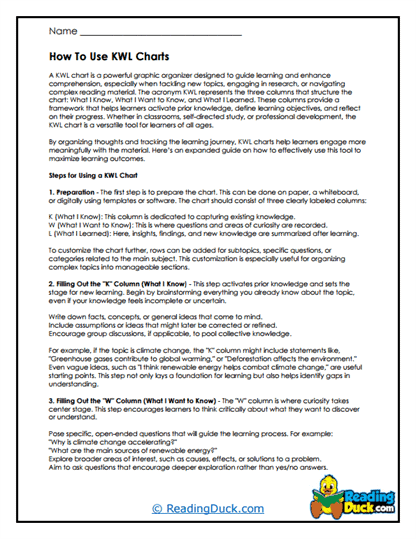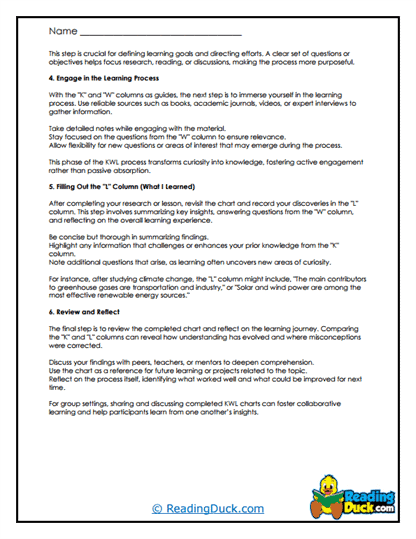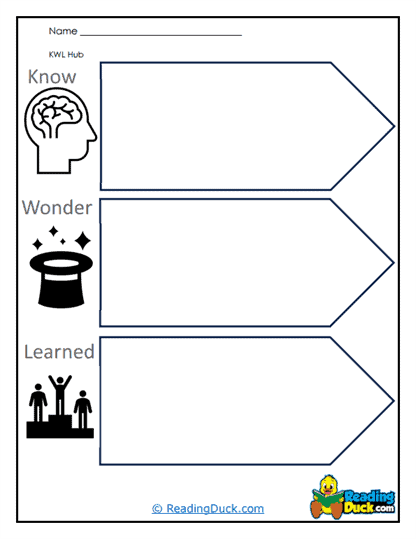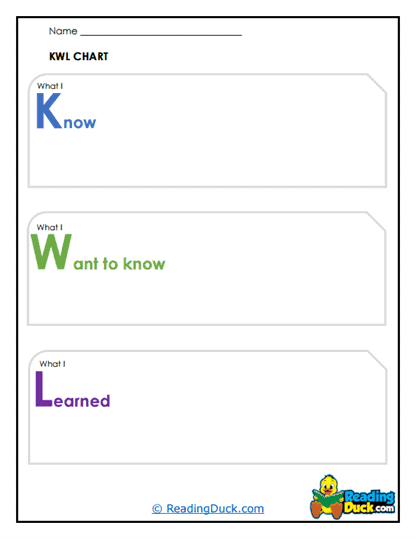KWL Charts Worksheets
About Our KWL Charts
A KWL Chart is a simple but powerful graphic organizer used primarily in educational settings to guide learning and comprehension. The acronym KWL stands for Know, Want to Know, and Learned, and these three components form the chart’s structure. Teachers often use KWL Charts to activate prior knowledge, set learning objectives, and reflect on acquired knowledge, making them a versatile tool for learners of all ages. Each part of the KWL process is integral to fostering meaningful engagement with a topic, and understanding the purpose of each can help maximize its benefits.
K: What I Know
The first column of the KWL Chart, labeled "Know," is where learners jot down what they already know about a topic. This step is crucial for activating prior knowledge, which research shows is a key factor in effective learning. By recalling and articulating their existing knowledge, learners set a foundation for connecting new information. This process not only helps identify relevant knowledge but also highlights misconceptions or gaps in understanding, which can be addressed during the learning process.
For teachers, the "Know" column provides valuable insight into their students' baseline understanding and can guide lesson planning. For example, if students demonstrate a strong grasp of certain concepts, the teacher can focus on advancing to more complex topics. Conversely, if significant gaps are evident, these can be prioritized. Additionally, the act of listing what they know builds confidence in learners, as it reminds them of the knowledge they bring to the table.
W: What I Want to Know
The second column, "Want to Know," is a space for learners to pose questions or identify areas of curiosity about the topic at hand. This phase is all about setting a purpose for learning. By explicitly stating what they want to know, learners take an active role in their education, which can boost motivation and engagement. It helps transform the learning process from a passive reception of information to an intentional quest for answers.
This step also encourages critical thinking as learners must reflect on what they find intriguing, unclear, or important about the subject. Teachers can use this column to tailor their instruction to align with students’ interests and needs, making lessons more relevant and engaging. Additionally, listing questions or areas of interest provides a roadmap for the learning journey, helping both teachers and students track progress as they move through the material.
L: What I Learned
The third column, "Learned," is completed at the end of the learning process and serves as a reflective space where students consolidate and articulate what they have gained. This step reinforces retention by requiring learners to process and summarize their new knowledge in their own words. It also provides an opportunity to evaluate how well their initial questions were answered and whether their learning goals were achieved.
For teachers, the "Learned" column serves as an assessment tool to gauge student understanding and identify areas that may require further clarification or review. It also helps validate the learning experience by showing tangible evidence of progress. By comparing the "Know" and "Learned" columns, students can appreciate their growth, fostering a sense of accomplishment and encouraging a mindset of continuous learning.
The Benefits of KWL Charts
KWL Charts are a highly effective tool in educational settings because they provide a structured yet flexible framework for both students and teachers to navigate the learning process. For students, KWL Charts promote active participation in their learning journey. By starting with the "Know" column, students activate prior knowledge, helping them recall what they already understand about a topic. This process not only builds confidence but also creates a mental scaffold for incorporating new information. The act of organizing their thoughts and existing knowledge primes students to absorb and retain new concepts more effectively.
For teachers, the "Know" column offers invaluable insights into students' starting points. Understanding what students already know allows teachers to tailor their instruction to better meet learners' needs. For instance, if a significant number of students demonstrate a solid grasp of certain basics, the teacher can move on to more advanced material, avoiding redundancy. Conversely, if gaps or misconceptions are identified, teachers can address these issues directly. This adaptability enhances the relevance and efficiency of instruction, ensuring time and resources are directed where they are most needed.
The "Want to Know" column is particularly powerful for fostering curiosity and motivation among students. When students articulate what they want to learn, they take ownership of their education, transforming learning into an active pursuit rather than a passive experience. This intrinsic motivation is a critical factor in deep learning and retention. Additionally, crafting specific questions or areas of inquiry helps students develop critical thinking skills, as they must analyze what they do not understand or what intrigues them about the topic. For teachers, this column provides guidance on how to design lessons that align with students' interests, making the material more engaging and personalized.
The final "Learned" column supports both assessment and reflection. For students, writing down what they have learned solidifies their understanding and provides a sense of accomplishment. By comparing their initial knowledge with what they have acquired, students can see tangible evidence of their progress, which can boost confidence and encourage a mindset of continuous improvement. For teachers, this column acts as a formative assessment tool, allowing them to evaluate the effectiveness of their instruction. If students’ responses indicate gaps or confusion, teachers can adjust their teaching strategies accordingly. The reflective aspect of the "Learned" column also fosters metacognition, helping students become more aware of their own learning processes.
They are a simple yet versatile tool that enhances learning for students and provides critical insights for teachers. By activating prior knowledge, driving curiosity, and consolidating new information, they create a dynamic and engaging learning experience. For teachers, they serve as both a planning and assessment tool, enabling instruction that is responsive to student needs. Together, these benefits make KWL Charts an invaluable resource in education.









